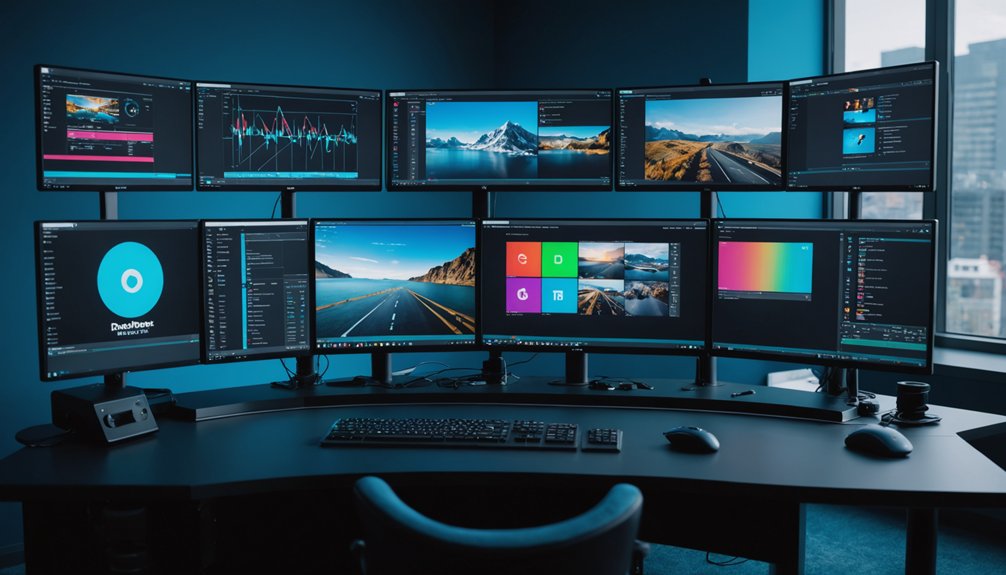Video marketing continues to dominate digital strategies heading into 2025. Consumers now expect visual content by default, with quality directly impacting brand trust. AI tools are revolutionizing production efficiency while traditional editing skills remain valuable. In this competitive landscape, creativity trumps budget—authentic content often outperforms polished productions. Data-driven approaches are essential, as different video formats yield varying ROI across platforms. Emotional engagement drives results, with humor and authenticity fostering stronger connections. The battle for attention has never been fiercer.

Nearly every marketer today is scrambling to master video content. It’s not just a nice-to-have anymore—it’s essential. The landscape has shifted dramatically, with consumers now expecting visual information as their default. No wonder 92% of marketers see video as critical to their future strategies. They’re not wrong.
AI is changing everything. Generative tools now create video clips that would’ve taken experts days to produce. But don’t fire your video editor just yet. Traditional editing skills remain valuable despite the tech revolution. The human touch still matters, imagine that. Tools like Autodraft’s smart editing features are transforming how content creators approach video production.
Quality matters. A lot. Research shows 91% of consumers judge brand trustworthiness based on video quality. Bad lighting and shaky footage? Your credibility just took a nosedive. Consumers aren’t forgiving anymore.
The competition is fierce. Everyone’s making videos now. Your competitor’s intern with a smartphone might be your biggest threat. Standing out requires creativity, not just budget. Sometimes lo-fi, authentic content performs better than polished corporate productions. Weird, right? With TikTok downloads reaching 825 million, the battle for attention has never been more intense.
Smart marketers are adapting fast. They’re adding captions—because most people watch without sound. They’re studying platform algorithms like they’re preparing for final exams. They’re experimenting with editing techniques that grab attention in crowded feeds. Video dominates social media platforms in 2025, with algorithms clearly favoring this format across all major networks.
Emotional engagement drives results. Videos that make people feel something—anything—outperform neutral content every time. Authenticity and humor work. So does jumping on trends. Miss a trending topic, and you’ve missed your moment.
Data should drive your strategy. Some video formats deliver better ROI than others. Some platforms work better for specific industries. The marketers who test, measure, and adjust are winning. With video content accounting for 82.5% of traffic, it’s imperative to optimize your brand’s video presence online.
AI will continue reshaping video marketing. It’s improving editing efficiency, enabling innovative storytelling approaches, and making amateur footage look professional. The future of content creation is being rewritten in real-time. Better keep up. The visual revolution waits for no one.
Frequently Asked Questions
How Much Should I Budget for Video Marketing Campaigns?
Most businesses allocate 11-50% of their marketing budget to video.
The sweet spot? 21-30%. That’s what the data shows.
Companies are all-in on this trend, bumping up video budgets by 25% annually.
No surprise there – 90% of marketers say video delivers good ROI.
The numbers don’t lie.
Whether you’re just starting or going all-in, most marketers believe video is worth the investment.
Results speak for themselves.
What Video Metrics Truly Correlate With Increased Sales?
The metrics that actually drive sales? Not what you’d think.
While 66% of marketers obsess over likes and shares, the real money’s in lead generation and clicks, tracked by 49% of the smart ones.
Hard truth: 84% of video marketers report direct sales increases, but only 30% actually measure ROI through sales figures.
Dwell time matters too—keeps visitors around longer.
Short videos (30 seconds to 2 minutes) kill it.
Fancy production? Waste of cash.
Authentic content sells.
When Is Live Streaming More Effective Than Pre-Recorded Content?
Live streaming trumps pre-recorded content when real-time interaction matters.
It’s killer for Q&A sessions, product launches, and breaking news. The immediacy creates authenticity—viewers love those unscripted moments. Can’t fake that stuff.
Cost-wise? No editing needed. Shoot and go.
It works especially well for demonstrations where audience questions shape the presentation. Behind-the-scenes glimpses feel exclusive.
And when something unexpected happens? That’s marketing gold you couldn’t plan for.
Choose wisely though. Some content needs polish.
How Do Video Content Strategies Differ Across Global Markets?
Video strategies vary dramatically across global markets.
Cultural influences are huge—what works in the UK bombs in Brazil. Language? Obviously critical.
YouTube dominates globally, but TikTok’s climbing fast with the youth. Mobile consumption rules emerging markets, while desktop still matters elsewhere.
Short-form content’s universal, surprisingly. Regional platforms can’t be ignored either.
And let’s face it—local personalization isn’t optional anymore. Brands ignoring cultural sensitivity? They’re asking for trouble.
Analytics tell the real story anyway.
Which Video Editing Tools Offer the Best ROI for Small Businesses?
Small businesses get the most bang for their buck with free tools like DaVinci Resolve and iMovie.
They’re powerful without emptying wallets. Canva Video works great for quick social media content—no film degree required.
Mobile options like KineMaster let you edit on the go. Seriously, who has time for complicated software?
The best ROI comes from matching the tool to your needs.
Professional results without professional prices. That’s the whole point, isn’t it?




